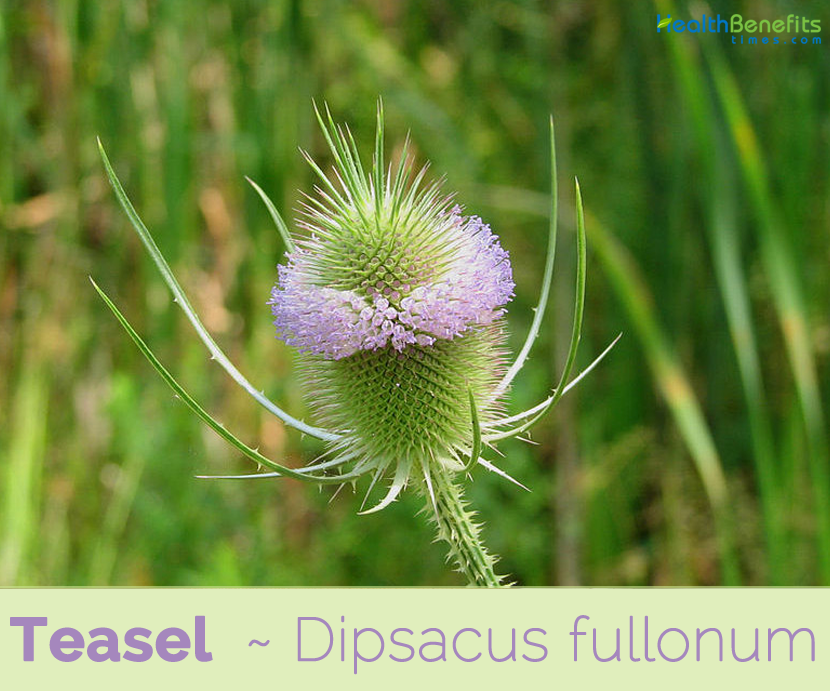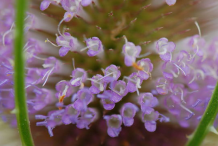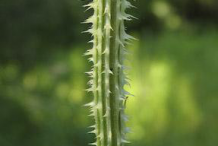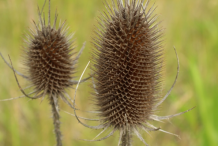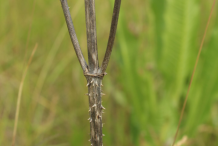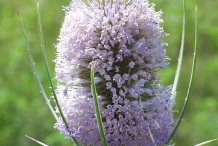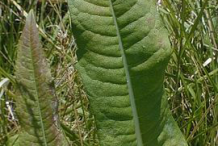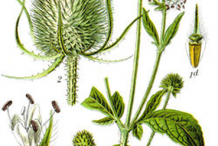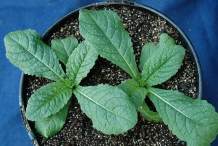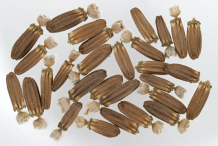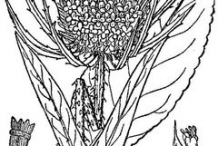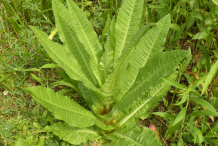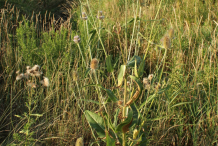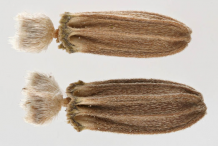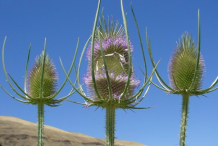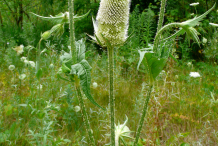Plant Description
Teasel is a tall, somewhat spiny, herbaceous, robust, biennial prickly and monocarpic perennials plant that grows about 7 to 10 feet (2-3 m) tall. The plant is found growing in mesic prairies (especially cemetery prairies), degraded grassy meadows, creeks, savannas, woodland borders, pastures and abandoned fields, landfills, roadsides, and waste areas, roadsides, ditches and in pastures, old fields, riparian areas and forest edges. The plants grow on a variety of soils from sandy soils with abundant moisture to heavy clays in poorly drained areas. The plant has stout taproot with a fibrous secondary root system that are more than 2 feet (0.6 m) long and 1 inch (2.5 cm) in diameter at the crown. Erect, hollow, hairless stems are pale green to reddish green. They have scattered white prickles and flat longitudinal ridges.
Leaves
Opposite leaves are up to 12 inches long and 3inches across. They are green, yellowish green, or reddish green, lanceolate to linear-lanceolate, ascending to spreading, and rather stiff in texture. Their margins are smooth, slightly prickly, or irregularly toothed. On the upper surface of each leaf, there is a white central vein, while on the lower surface this vein has stout prickles. The lower opposite leaves are sessile, while the upper opposite leaves are perfoliate or clasping. All leaves are hairless. The leaves are fused around the stem forming a saucer-like shape that holds rainwater.
Flowers & Fruits
Teasel flowers occur in terminal, stiff, egg-shaped heads that are up to 4 inches (10 cm) long. The entire flower head (peduncle) measures anywhere between 50 and 100 centimeters in height and consists of tiny individual flowers that measure 10 to 15 mm long. Inflorescences contain 250 to 1,500 flowers, which bloom for only 1 day. Flowering begins in the middle of the inflorescence and then progress up and down. Often there are few flowers blooming at the same time. Flower heads are subtended by linear bracts that are about 4 times as long as they are wide. Individual flowers, which are 2/5 to 3/5 inch long, consist of white petals united into a tube with 4 purple lobes. Below each cluster are several long, slender, stiff, bracts that curve upward. Within the cluster, there are many short, stiff bristles. Once mature, flower clusters become dry, hard, and persistent. Teasel flowers appear between late June and September. Flowers are followed by light brown, ridged, hairy, and 4 angled achenes that measure up to 8 mm long. Enclosed in each fruit is a single seed. Seeds are small and are spread by the wind after the seed-head has dried.
Health Benefits of Teasel
Teasel plant consists of several health benefiting vitamins and minerals. Listed below are few of the health benefits of teasel
1. Treats osteoporosis and osteopenia
Teasel is widely used in traditional Chinese Medicine as a liver and kidney toner. Teasel Root is categorized as a Yang tonic with an affinity for assisting with structural repair especially of connective tissue and bone. It increases circulation and aids in building strong tendons and bones. Apart from that teasel root helps damaged bone tissue grow, stimulating new bone growth. It also helps alleviate muscle pain. Recent research shows that Teasel Root helps strengthen and build bone mass, particularly in porous trabecular bone.(1)
2. Helps rid the body of chronic Lyme disease
Lyme disease is normally caused by a bacteria (Borrelia burgdorferi), transmitted to humans by infected black legged ticks. Symptoms vary, but can include fever, fatigue, headaches, and a skin rash. A couple weeks of antibiotics can help clear Lyme disease from the body. Chronic Lyme disease, however, is something many people suffer from. Chronic Lyme disease happens when antibiotics fail to heal the body, and fatigue, headaches and other symptoms linger, often longer than six months. Teasel Root is not an antibiotic, but a weed that is capable of changing the body’s environment, so the body can kill off Lyme bacteria. The body’s muscles and cells are stimulated and it helps dump Lyme bacteria into the bloodstream, and then the body can detox it. (2)
3. Natural diuretic
Teasel Root is considered an excellent diuretic, making it wonderful for clearing the body of excess water weight, as it encourages the flow of urine. This dynamic root also encourages sweating, which is another way to rid the body of toxins (sweating acts as a diuretic). It rids the body of unneeded salt and water, which can also help with tissue swelling (inflammation).
4. Helps treat Candida overgrowth
Although Candida is present in everyone’s bodies, it is a fungus, and when it gets out of control, it can result in various maladies such as yeast infections, depression, chronic fatigue, or infection of our gut flora. Teasel Root works with natural antibiotics, and aids in purging excess Candida into our bloodstream so that it can die-off. Inulin is part of the Teasel Root, and helps probiotic growth in the colon. Probiotics, which are live bacteria and yeasts, are good or helpful bacteria. It’s the stuff that keeps our guts healthy. Pro means for, and bio in this definition means life; therefore, probiotics are for life. Taking teasel root if you have candida overgrowth can force candida from tissues, and the exposure allows probiotics to attack and conquer the offending enemies.
5. Jaundice
Jaundice is a common liver problem. The appearance of light or a dark-yellow coloring of the skin and eyes is known as jaundice. Jaundice is not a disease, but can be related with other problems, such as acute inflammation of the liver, alcoholism, liver infection or cancer, and bile duct inflammation. Elevated bilirubin is an orange-yellow substance made during the normal breakdown of red blood cells. Bilirubin passes through the liver and is eventually excreted out of the body, and causes the yellowing of skin and/or eyes.” The diuretic properties of Teasel Root support the liver to clear the body of toxins.
Traditional uses and benefits of Teasel
- Water collected by the leaves of teasels was thought to remove freckles.
- It has also been used to soothe sore eyes.
- Roots have been used to treat warts, sores, and other skin problems.
- Water that collects in stem-clasping leaves has been used to soothe eye inflammation.
- Teasel roots have been used to treat ulcers, jaundice, warts, and cleanse wounds.
- Traditionally it has been used to treat conditions such as warts, fistulae (abnormal passages opening through the skin) and cancerous sores.
- Root is diaphoretic, diuretic and stomachic.
- An infusion is said to strengthen the stomach, create an appetite, remove obstructions of the liver and treat jaundice.
- An infusion of the leaves has been used as a wash to treat acne.
- Plant has a folk history of use in the treatment of cancer.
- An ointment made from the roots is used to treat warts, wens and whitlows.
- Homeopathic remedy is made from the flowering plant.
- It is used in the treatment of skin diseases.
- It’s also taken internally to strengthen the knees and back and soothe away pain.
- Teasel root is also used for treating osteoporosis and osteopenia.
- Powder teasel root is used for pain, swelling, and inflammation of the skin and for open wounds.
- Fried teasel root is good for treating bleeding during pregnancy and for excessive bleeding during periods.
- Teasel root has been used to treat Lyme disease symptoms, and some find teasel root very important in their recovery from Lyme disease.
- Teasel root has also been used for hundreds of years to treat bladder infections.
- Teasel root has also been used for eye irritation and swelling.
- Teasel root is a very good diuretic making it great for excess water weight.
- Teasel root is a good detoxing agent for the liver and kidneys.
- Teasel root is great for improving digestion and healing diarrhea.
- This herb is also beneficial in curing jaundice.
- A teasel salve or massage oil can work similarly and is useful to incorporate into a recovery routine for
athletes who commonly face overuse injuries from training.
Culinary Uses
- Young leaves are edible although one must take great care to avoid the spiny, stout hairs.
- Teasel leaves can be consumed raw, cooked or added to a smoothie.
- Root can be used in a tea or for making vinegar or tinctures.
Other Facts
- Teasel is best known in the textile industry for its use in raising the nap of fabrics, but teasel also has some medicinal uses.
- Seeds are an important winter food resource for some birds, notably the European Goldfinch.
- Teasels are also occasionally grown as ornamental plants, and the dried heads are used in floristry.
- Blue dye obtained from the dried plant is an indigo substitute.
- Yellow is obtained when the plant is mixed with alum.
- Teasels are also occasionally grown as ornamental plants, and the dried heads are used in floristry.
- Teasels are often grown in gardens and encouraged on some nature reserves to attract them.
- The plant is considered a rich source of pollen as well as nectar for bees and other insects.
- Formerly widely used in textile processing, providing a natural comb for cleaning, aligning and raising the nap on fabrics, particularly wool.
- Teasel flowers bloom for only 1 day, and plants die after flowering.
- Teasel plants may produce over 3,000 seeds.
References:
https://www.itis.gov/servlet/SingleRpt/SingleRpt?search_topic=TSN&search_value=35404#null
https://davesgarden.com/guides/pf/go/1960/
http://www.hear.org/pier/species/dipsacus_sativus.htm
https://pfaf.org/user/Plant.aspx?LatinName=Dipsacus+fullonum
https://www.cabi.org/ISC/datasheet/119605
http://www.floracatalana.net/dipsacus-fullonum-l-subsp-fullonum
https://botanical.com/botanical/mgmh/t/teazle09.html
https://plants.usda.gov/core/profile?symbol=DIFU2
http://www.theplantlist.org/tpl1.1/record/kew-2771857
https://en.wikipedia.org/wiki/Dipsacus_fullonum
http://www.oardc.ohio-state.edu/weedguide/single_weed.php?id=98
Comments
| Teasel Quick Facts | |
|---|---|
| Name: | Teasel |
| Scientific Name: | Dipsacus fullonum |
| Origin | Eurasia and North Africa, but it is known in the Americas, southern Africa, Australia and New Zealand |
| Colors | Light brown |
| Shapes | Hairy achenes that measure up to 8 mm long |
| Health benefits | Treats osteoporosis and osteopenia, Natural diuretic, Helps rid the body of chronic Lyme disease, Helps treat Candida overgrowth and Jaundice |
| Name | Teasel |
|---|---|
| Scientific Name | Dipsacus fullonum |
| Native | Eurasia and North Africa, but it is known in the Americas, southern Africa, Australia and New Zealand |
| Common Names | Fuller’s teasel, Common teasel, Teasel, Venuscup teasle, Wild teasel, Draper’s teasel, Card Teasel, cardère sylvestre, Common Teazle, Fuller’s Teazle, Indian teasel, cut-leaved teasel, Adam’s Flannel, Church Broom, Prickly Back, and Water Thistle |
| Name in Other Languages | Catalan: Cardo, Cardó, Escardot, Rierenca Chinese: Qǐ róng cǎo (起绒草) Danish: Gærde-kartebolle Dutch: Grote kaardebol, Grote kaardenbol English: Fuller’s teasel, Common teasel, Teasel, Venuscup teasle, Wild teasel, Draper’s teasel, Card Teasel, cardère sylvestre, Common Teazle, Fuller’s Teazle, Indian teasel Finnish: Laidunkarstaohdake French: Cabaret des oiseaux, Cardaire sauvage, Cardère des bois, Cardère sylvestre, Cardère à foulon, Cardère cultivée, chardon des forêts German: Wilde Karde Occitan: Cardons, Cardoun bastard, Cardèra, Pencheneta, Èrba de gobelet Portuguese: Cardo-cardador, Cardo-penteador Spanish: cardencha, Cardo de cardar, carda, cardilla, cardo, Cadillo, Carda, Cardancha, Cardo de cardadores Swedish: Kardvädd, Vild kardvädd, kardtistel |
| Plant Growth Habit | Tall, somewhat spiny, Herbaceous, robust, biennial prickly, monocarpic perennials |
| Growing Climates | Mesic prairies (especially cemetery prairies), degraded grassy meadows, creeks, savannas, woodland borders, pastures and abandoned fields, landfills, roadsides, and waste areas, roadsides, ditches and in pastures, old fields, riparian areas and forest edges |
| Soil | Grows on a variety of soils from sandy soils with abundant moisture to heavy clays in poorly drained areas |
| Plant Size | 7 to 10 feet (2-3 m) tall |
| Root | Stout taproot with a fibrous secondary root system that are more than 2 feet (0.6 m) long and 1 inch (2.5 cm) in diameter at the crown |
| Stem | Erect, hollow, Hairless stems are pale green to reddish green; they have scattered white prickles and flat longitudinal ridges |
| Leaf | Opposite leaves are up to 12 inches long and 3inches across; they are green, yellowish green, or reddish green, lanceolate to linear-lanceolate, ascending to spreading, and rather stiff in texture. Their margins are smooth, slightly prickly, or irregularly toothed. |
| Flowering Season | July to August |
| Flower | Teasel flowers occur in terminal, stiff, egg-shaped heads that are up to 4 inches (10 cm) long. Inflorescences contain 250 to 1,500 flowers, which bloom for only 1 day. |
| Fruit Shape & Size | Hairy achenes that measure up to 8 mm long |
| Fruit Color | Light brown |
| Seed | Seeds are small and are dispersed by the wind after the seed-head has dried. |
| Plant Parts Used | Root, heads |
| Available Forms | Capsules, powders, pills, teas, tinctures, and also raw, cooked, and fried forms |
| Season | August to October |
| Health Benefits |
|


